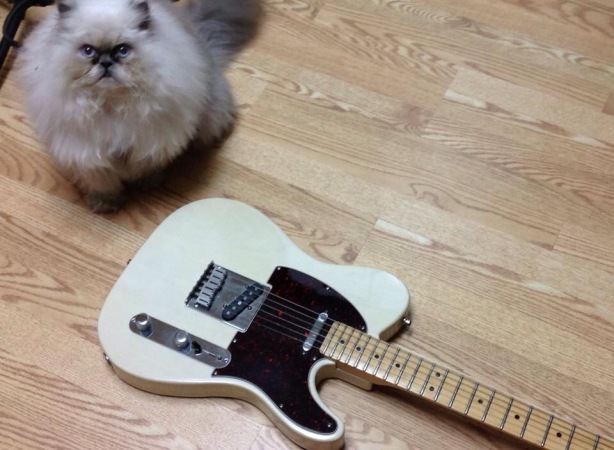I used to own a Fender American Standard Telecaster and a Fender American Standard Stratocaster. Why did I own both and which one did I sell?
Fender Guitars make arguably the most popular guitars in the world. Of their many offerings, two models have stood out as clear favorites among players everywhere. With a combination of playability, unique and delicate tone and affordability, Fender became the choice of professional musicians around the world. The first electric, solid body guitars mass produced were the Fender Telecaster in 1950, the Gibson Les Paul in 1952, and the Fender Stratocaster in 1954. These three founders of the world of electric guitar have retained their popularity over the years and still remain among the most sought after guitars by musicians of yesterday and today.
Fender’s two primary designs offered a similar set of features with a few notable differences. The Stratocaster (Strat) is a double cutaway, alder or ash body with a bolt-on one piece maple (or maple with rosewood fretboard) neck adorned with 21-22 jumbo frets, and loaded with three single coil pickups. It’s older brother, the Telecaster (Tele) features an alder or ash, single cutaway body, 21-22 jumbo frets pressed into a one piece maple neck or a maple neck with rosewood fretboard, a single coil bridge pickup and a lipstick neck pickup. Both of these suckers hum while idling.
The stats on these guitars are similar, and their sound is uniquely Fender. Both guitars sound similar, and are distinguishable from just about every other guitar out there. There are some subtle differences that add up to bigger differences later, as you form a relationship with a guitar. There are two ways to discuss the differences of these guitars. One is all mathy and sciency. The other is all spacey and abstract. We’re going with the latter, since the comparison of their specs is mind numbing and ultimately not nearly as useful as experience with them. So, here we go.
Let me start with Strats and Teles are both genuinely great guitars. They have a modest price for professional level gear and offer consistent performance and reliability. Both guitars are incredibly versatile and can excel in nearly any style of music.

Stratocaster – 1998 Am. Std. Olympic White, Alder, One piece maple neck.
The best thing about the strat is definitely the huge sweep of tone from the bridge to the neck pickup. You have a ton of options at your finger tips at all times. The neck feels good and it’s pretty stable. I put 5 springs on the bridge and anchored that S.O.B. down, and she stays in tune for weeks on end. The bridge pickup sound is biting and hard, articulate and bright. With distortion coming from the Mesa/Boogie DC-5, it has a punchy and cutting sound. And a ton of idle buzz. The neck pickup provides a brilliant tone that is sweet and buttery, while being articulate and thin in the high end, but gritty and warm with the low notes. And a ton of idle buzz. The five-way pickup switch offers settings in the 2 and 4 positions which will drop the buzz almost entirely, at the cost of some of the tone you had on the extreme pickup settings. My solution was a Boss NS-2 Noise Suppressor pedal. If nothing else, it stopped the idle buzz with the noise gate between songs. The contour body shape of the Strat is both comfortable and snappily stylish. With strategic cuts on the back and front of the body, the Strat allows the guitar to fit the geometry of a body very comfortably. If the sound of the Strat were teeth, it would have sharper teeth than a Tele. But don’t underestimate the Tele’s appetite.

Telecaster – 1999 Am. Std. White Blonde, Ash, One piece maple neck.
Teles were the first mass produced, solid body, electric guitar. A simple design with now vintage appeal. The bottom end sound of a Tele is much thicker than its younger brother. The guitar itself is a little heavier, which puts a little more resonant wood in your tone. Teles require some man handling. They don’t feel all buttery. They’re more raw and muscular. Both guitars are classics, but the Strat is like a ’60s Corvette and the Tele is more like a ’57 Chevy. It takes a little more finesse to get what you want out of the ’57, but it’s not inferior in any way. The Tele has its own issues with buzz, though in my experience the Strat is worse for buzz overall, but both are worse than any humbucker loaded guitar. This Tele is a hard tail, so tuning is not an issue. Stays in tune no matter what I put it through.
So, they’re very similar, yet totally different. In a perfect world, I can get the Strat bridge pickup sound for distortion and the Tele neck pickup sound for clean. But that doesn’t exactly exist. The good news is that the Tele bridge is still a great sound, and the Strat neck is a good sound, too. So it came to priorities. The hard tail Tele holds better tune and is less buzzy with a more rich clean sound and healthy bridge sound. They aren’t redundant, but almost. At one point, I realized I had not taken my Strat out of the case for almost two years, and I sold it. The Tele can almost imitate the Strat. The Strat really can’t imitate the Tele. I got the Strat first, and then the Tele. I wanted a Tele first, but the Strat was the right price at the right time. Over and over, year after year I reached for the Tele over the Strat. And now the Tele sits among the guitars the will be passed on through my family, because it’s never going up for sale. Still considering putting a Strat back in the collection though, though the call for it doesn’t ring too often.




